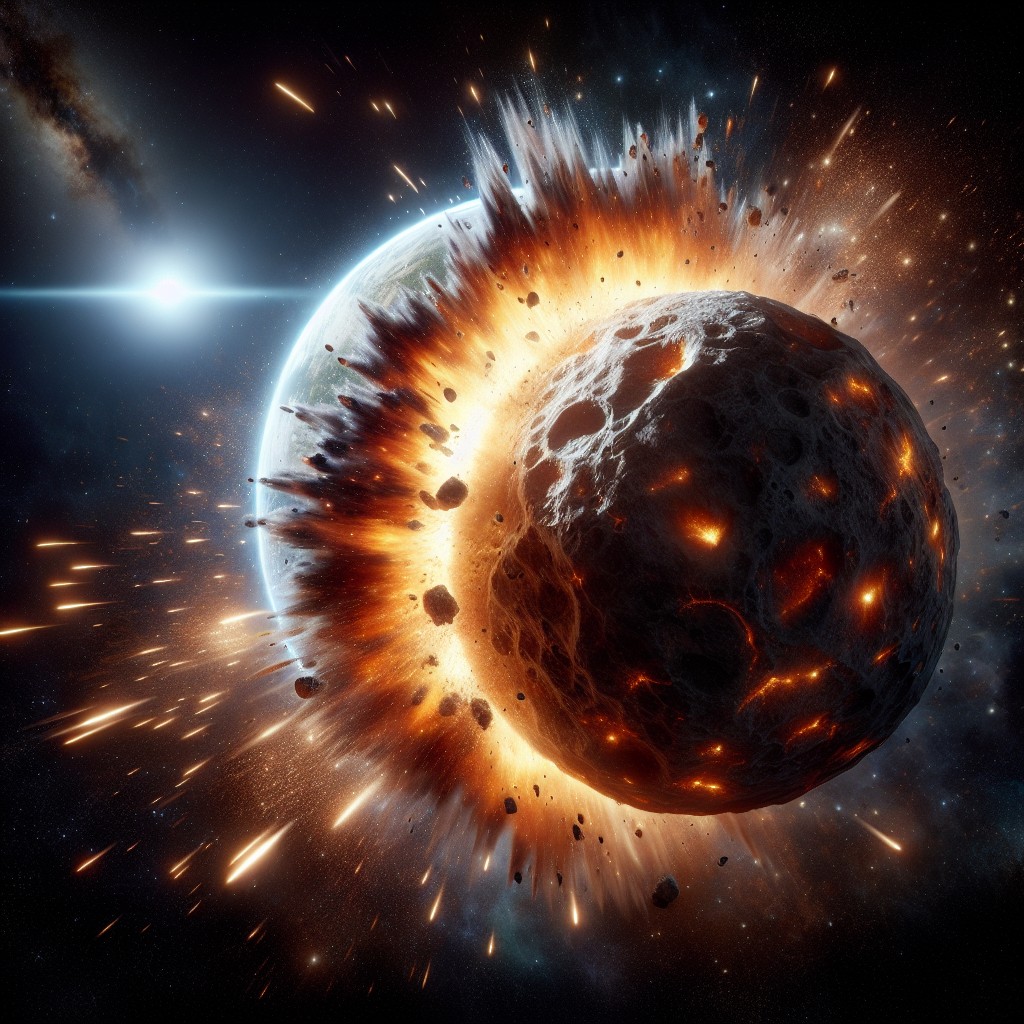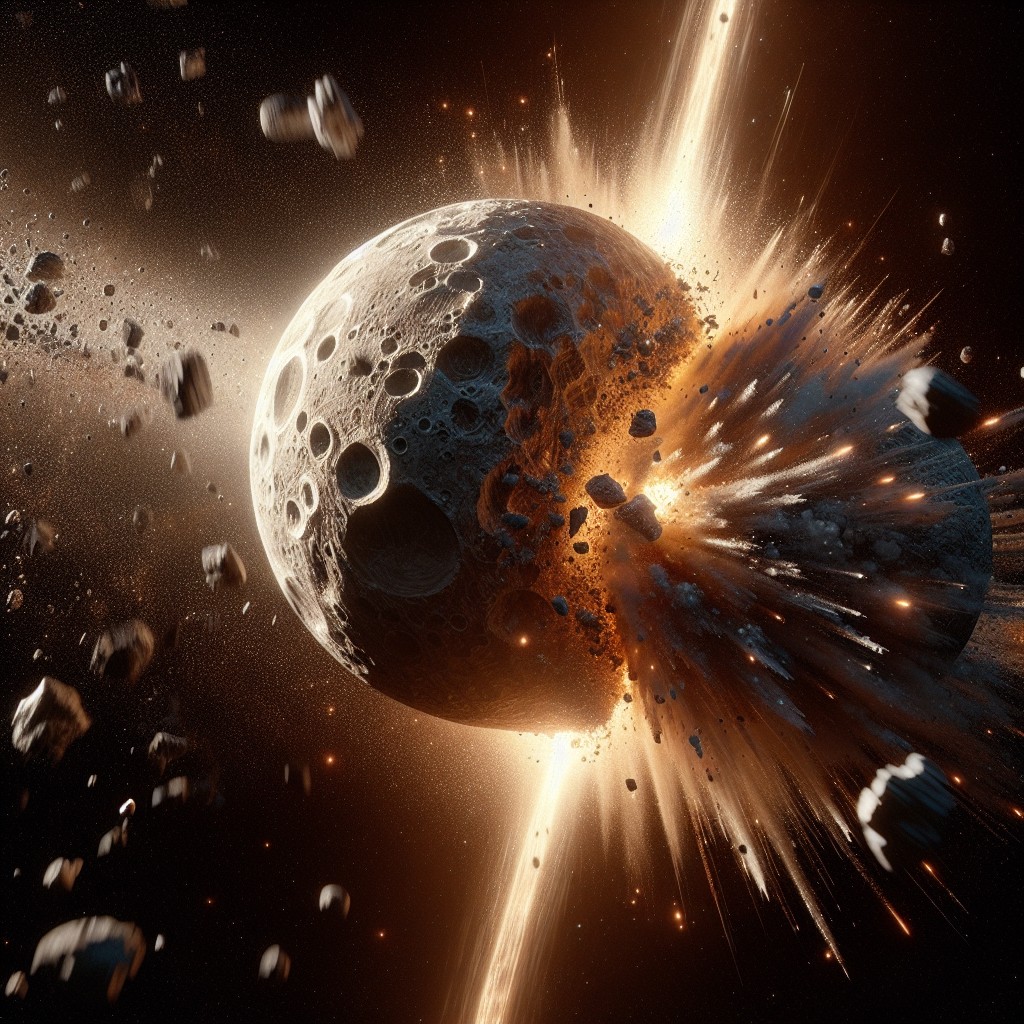
Hadean Eon (4.6 – 4.0 billion years ago) – Earth forms; Theia impact creates the Moon.
The Hadean Eon, a term derived from the Greek word “Hades,” refers to the earliest period in Earth’s history, spanning from approximately 4.6 billion years ago to about 4 billion years ago. This eon is characterised by extreme conditions that were inhospitable to life as we know it today. The Hadean is not merely a time frame; it represents a formative phase in the development of our planet, during which the fundamental processes that would shape Earth and its environment took place.
The name itself evokes images of a hellish landscape, reflecting the tumultuous and chaotic nature of this era. During the Hadean Eon, the Earth was still in its infancy, forming from the primordial accretion of dust and gas surrounding the young Sun. This period was marked by intense geological activity, including frequent volcanic eruptions and the constant bombardment of meteoroids.
The surface of the planet was molten, and temperatures were exceedingly high, creating a dynamic environment that would eventually lead to the formation of a stable crust. Understanding the Hadean Eon is crucial for comprehending the subsequent development of Earth and the conditions that would eventually allow for the emergence of life.
Summary
- The Hadean Eon is the earliest eon in Earth’s history, lasting from 4.6 to 4 billion years ago.
- Earth formed from the accretion of dust and gas in the solar nebula, leading to the differentiation of its layers.
- The Theia Impact refers to the collision between Earth and a Mars-sized body, leading to the formation of the Moon.
- The creation of the Moon had a significant impact on Earth’s geological and atmospheric conditions, leading to the development of tectonic activity and the stabilisation of the atmosphere.
- The Hadean Eon marked the early stages of Earth’s development, including the emergence of oceans and the potential for early life forms.
The Formation of Earth
The formation of Earth is intricately linked to the processes that occurred in the early solar system. Approximately 4.6 billion years ago, a rotating disc of gas and dust, known as the solar nebula, began to collapse under its own gravity. As this material coalesced, it formed the Sun at its centre, while the remaining particles began to clump together to create the planets, including Earth.
This process of accretion involved countless collisions between particles, leading to the gradual accumulation of mass and energy. As Earth formed, it underwent significant differentiation due to the heat generated by these collisions, as well as radioactive decay. Heavier elements, such as iron and nickel, sank towards the centre, forming the core, while lighter silicates rose to create the mantle and crust.
This differentiation was crucial for establishing the planet’s layered structure and setting the stage for future geological processes. The intense heat during this period meant that much of the surface remained molten for an extended time, preventing the formation of a stable crust until later in the Hadean Eon.
The Theia Impact

One of the most significant events during the Hadean Eon was the hypothesised impact between Earth and a Mars-sized body known as Theia. This colossal collision is believed to have occurred around 4.5 billion years ago and played a pivotal role in shaping both Earth and its satellite, the Moon. The impact would have released an enormous amount of energy, equivalent to millions of nuclear bombs, resulting in widespread melting of Earth’s surface and ejecting vast amounts of debris into space.
The debris from this cataclysmic event eventually coalesced to form the Moon. This theory, known as the Giant Impact Hypothesis, explains not only the Moon’s origin but also its composition, which is strikingly similar to that of Earth’s outer layers. The Theia impact had profound implications for Earth’s development; it altered its rotational dynamics and contributed to the stabilisation of its axial tilt, which is crucial for maintaining a stable climate over geological timescales.
The Creation of the Moon
The creation of the Moon is a fascinating chapter in Earth’s early history, intricately linked to the Theia impact. Following this colossal collision, debris was ejected into orbit around Earth, forming a disc of material that gradually coalesced under gravitational forces. Over time, this material clumped together to form what we now recognise as the Moon.
The Moon’s formation had significant consequences for Earth. Its gravitational influence plays a crucial role in stabilising Earth’s axial tilt, which affects seasonal variations and climate patterns.
Additionally, the presence of the Moon has been linked to tidal forces that have shaped coastal ecosystems and influenced biological evolution. The Moon’s surface bears scars from its own tumultuous history, including craters formed by impacts from other celestial bodies during a period known as the Late Heavy Bombardment, which occurred shortly after its formation.
Geological and Atmospheric Conditions
During the Hadean Eon, geological and atmospheric conditions were extraordinarily hostile. The surface was dominated by volcanic activity, with lava flows and gas emissions creating a dynamic landscape. As volcanic eruptions released gases such as water vapour, carbon dioxide, and nitrogen into the atmosphere, they contributed to a thick primordial atmosphere that was vastly different from what we experience today.
This atmosphere was likely devoid of free oxygen and rich in greenhouse gases, creating a greenhouse effect that kept surface temperatures high. The relentless bombardment by meteoroids further shaped Earth’s surface during this time. Impacts would have created craters and released additional gases into the atmosphere while also contributing to heating through kinetic energy transfer.
As cooling began to occur towards the end of the Hadean Eon, some regions may have started to solidify into a crust, although this crust would have been unstable and subject to re-melting due to ongoing volcanic activity. The interplay between geological processes and atmospheric conditions set the stage for future developments in Earth’s history.
Early Life on Earth
While definitive evidence for life during the Hadean Eon remains elusive due to the extreme conditions prevalent at that time, some scientists speculate that simple life forms may have emerged in isolated niches where conditions were more favourable. Hydrothermal vents on the ocean floor could have provided a stable environment with access to essential minerals and energy sources necessary for life. These vents are known to host extremophiles today—organisms that thrive in extreme conditions—suggesting that similar life forms could have existed in Earth’s early history.
The transition from non-life to life is one of science’s most profound mysteries. If life did indeed arise during this eon, it would have been simple and unicellular, likely resembling modern prokaryotes such as bacteria or archaea. These early organisms would have played a crucial role in shaping Earth’s atmosphere by contributing to chemical processes that eventually led to oxygen production—a key factor in paving the way for more complex life forms in subsequent eons.
The End of the Hadean Eon
The Hadean Eon came to an end around 4 billion years ago as Earth began transitioning into what is known as the Archean Eon. This transition was marked by significant changes in geological activity and atmospheric composition. As cooling continued, a more stable crust began to form, allowing for the development of oceans as water vapour condensed and accumulated on the surface.
This shift created an environment more conducive to life. The end of the Hadean Eon also saw a reduction in meteoroid impacts as Earth settled into a more stable orbit around the Sun. The cooling crust allowed for tectonic processes to begin shaping landforms and creating continental masses over geological timescales.
These changes laid down essential foundations for future biological evolution and paved the way for more complex ecosystems that would emerge in later eons.
Significance of the Hadean Eon
The significance of the Hadean Eon extends far beyond its status as Earth’s earliest period; it represents a critical phase in planetary formation and evolution. Understanding this eon provides insights into how planets develop under extreme conditions and how those conditions can influence future habitability. The processes that occurred during this time laid down essential geological features and atmospheric conditions that would ultimately support life.
Moreover, studying the Hadean Eon helps scientists comprehend not only Earth’s history but also that of other celestial bodies within our solar system and beyond. By examining similar processes on exoplanets or moons with potential subsurface oceans—such as Europa or Enceladus—researchers can gain valuable insights into where life might exist elsewhere in the universe.
FAQs
What is the Hadean Eon?
The Hadean Eon is a geological eon that occurred from approximately 4.6 to 4.0 billion years ago. It is the earliest eon in Earth’s history and is characterized by the formation of the Earth and the intense bombardment of the planet by asteroids and comets.
How did the Earth form during the Hadean Eon?
During the Hadean Eon, the Earth formed through the process of accretion, where smaller particles collided and stuck together to form larger bodies. Over time, these bodies grew in size and eventually formed the Earth.
What was the Theia impact?
The Theia impact refers to a hypothesized collision between the early Earth and a Mars-sized protoplanet called Theia. This collision is believed to have occurred during the Hadean Eon and resulted in the formation of the Moon.
How did the Theia impact create the Moon?
The collision between the early Earth and Theia is thought to have ejected a significant amount of material into space, which eventually coalesced to form the Moon. This theory is known as the giant impact hypothesis and is widely accepted as the most plausible explanation for the Moon’s formation.
What were the conditions like on Earth during the Hadean Eon?
During the Hadean Eon, the Earth was a hostile and uninhabitable place, with extreme volcanic activity, high temperatures, and a lack of an atmosphere. The surface was constantly bombarded by asteroids and comets, making it a turbulent and volatile environment.


